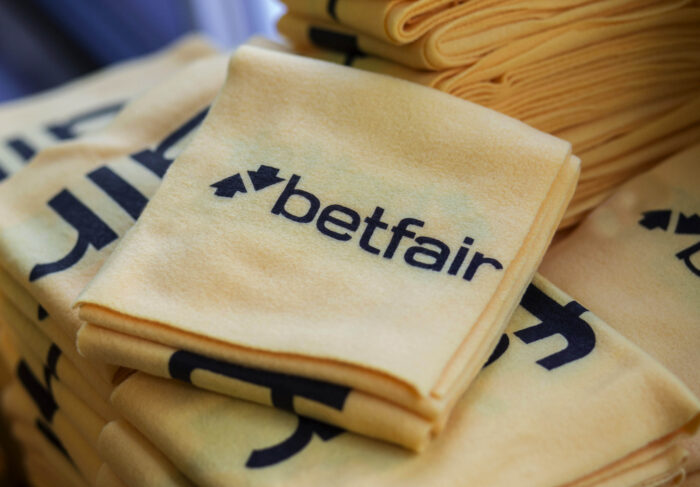Five things we learned from Flutter’s Q1 trading update
- UM News
- Posted 2 days ago
Another quarter and another strong performance from Flutter – the global behemoth that seems to be in perpetual growth motion and, despite adverse sports results in the US, shows little sign of stopping. While US full-year 2025 guidance was cut, the group is still expecting revenue for the 12 months to break $17bn (£12.8bn). M&A in the shape of Snaitech and Betnacional add more muscle in key markets.
FanDuel remains the top dog, with a US sports betting GGR market share of 43%. The igaming gains in the US are also showing on product and promotional pushes. And it means CEO Peter Jackson and CFO Rob Coldrake have a business under them in good stead. But, as Jackson has alluded to in the past, resting on their laurels isn’t part of the plan.
Here, EGR touches on key talking points from the business’ earnings call.
Don’t worry, we’ve got Betfair
The talk of the town in the US undoubtedly remains the rise of prediction markets, spearheaded by Kalshi. After a couple of legal wins against Nevada and New Jersey to allow it to continue offering sports event contracts, earnings calls for the foreseeable future will be peppered with analysts checking in on regulated sports betting operator’s plans to tackle the vertical. And while the legal ground is still yet to be solidified as terra firma, probing is taking place. The overarching reaction from execs thus far has been that the product is pretty plain. A lack of same game parlays (or bet builders in the UK) being the biggest gripe. But, Jackson said that should moves be made, Flutter was in a prime position due to the expertise garnered via the Betfair Exchange.
While exchanges have proven to be somewhat of a minor slice of the revenue and market share pie across the globe, the potential to bring a quasi-form of sports betting to US states without regulated markets is an enticing proposition.
Jackson mused: “We’re interested in the potential opportunity. We have brought some of our team who have experience in building these products and services from the Betfair Exchange and put them in to help us evaluate the opportunity. In states that haven’t regulated, there’s a ‘prime the pump’ type of opportunity that is not that dissimilar to some of the DFS stuff.
“We can see how important parlay mix is to a US audience and you can’t access that in the same way with something like an exchange. We’re very thoughtful about it. I think that for the states where sports betting is allowed, I’m not that confident that [prediction markets] will have a significant impact. But I think there are new markets.”

Hit the jackpot
Flutter also revealed further plans for its bid for the Italian National Lottery, having partnered with Scientific Games to launch an offer. The company is expecting to hear the result of the tender process in Q3 as it goes up against the incumbent manager IGT. Should it be successful in securing the nine-year licence, it will add the draw to its existing SuperEnalotto, which it runs via Sisal.
Cross-sell was championed by the duo on the call. Add in the fact Snaitech is now part of the Flutter group, and is expected to add $850m in revenue and $190m in adjusted EBITDA to full-year 2025, the Italian job is well underway. The Snaitech deal should make Flutter a market leader in the European nation, ahead of Lottomatica, while some €70m (£59.5m) in synergies are on the table.
On the benefits of securing Italy’s National Lottery, Coldrake said: “It’s low-risk and it’s highly profitable in its own right. If you look at the digitalisation of the product at the moment, its low single digits versus 30%-plus in France and 60%-plus in the UK.
“There’s an unexploited growth potential from a digital perspective. Cross-sell is a key component. The deal would be highly synergistic and the financial returns, we think, would be very compelling if we were to win the bid.”
Jackson added: “We’ve seen a really good example in the Italian market of being able to use our retail locations to cross-sell into online lottery and then expand the products available to customers from lottery to igaming and then sports [betting]. There’s no advertising allowed, so this is a great way of acquiring online customers.
Welcome to the party
Last month, Flutter also delved into the US peer-to-peer pick’em market with the launch of FanDuel Picks, launching across Alabama, Arkansas, Minnesota, Oregon and Wisconsin. And while the vertical was in the proverbial crosshairs last year, the regulatory and legal hubbub has somewhat settled, with market leaders PrizePicks, Sleeper and Underdog all offering the product to strong effect. It is that settling which Jackson said had convinced Flutter to enter the space, joining rivals DraftKings in doing so.
Jackson remarked: “We obviously have to be thoughtful about the regulatory position. I think from our perspective, we think that the law in many states has now been settled [and] peer-to-peer DFS [daily fantasy sports] is legal.
“I think that gave us the confidence to launch the peer-to-peer pick’em-style product in a handful of states. We’ll see how it works. It is a separate app using the same login details, but we’ll see what happens.”
Buzzer beater
One flag of concern raised in the results was a decline in basketball spend in the US, although overall stakes for FanDuel were in line with company expectations for the quarter. US handle was up 8% year on year (YoY) to $14.6bn, while management said Q2 was proving positive for Major League Baseball (MLB). Coupled with an “unprecedented” number of winning favourites in March Madness, and the sport was a slight blot on the report card.
However, Jackson and Coldrake both gave off a sense of comfortability with the swing, stating plans were in the pipeline, with margin still rising 50 basis points in the quarter to 7.8% and structural revenue margin ticking up to 14.1% on the back of expanded same game parlay penetration, specifically in the National Football League (NFL) and National Basketball Association (NBA).
Jackson said: “Basketball handle growth was lower than anticipated, offset by growth in other sports. We believe this handle softness is specific to the basketball market, and we have a number of commercial and product initiatives that will specifically enhance basketball engagement next season.
“You have to remember, there’s always going to be some ebbs and flows. We did see some weakness in basketball but we saw some very good strength off the back of the NFL. When I look at MLB performance at the moment, we’re very pleased with handle growth there too.”
Coldrake noted: “Basketball handle was perhaps slightly softer than anticipated. We attribute that to some factors, including some less competitive matchups over the course of the regular season that results in large spreads when it comes to betting. But, given our outsized position as market leader, we think the impact on us may be slightly disproportionate.”

Online casino opening
Despite the reluctance from US legislators to give the greenlight to further online casino expansion, FanDuel is ticking along strongly with its igaming proposition. Revenue for the vertical shot up 32% YoY to $472m in Q1 on the back of a 28% rise in average monthly players to 985,000. Bosses also noted that efforts to directly acquire casino players, rather than cross-sell from sports, were paying off.
As a result, FanDuel’s market share for igaming now sits at 27%. The plan is to expand this further, tapping into new product developments such as BeyondPlay’s jackpot offering and in-house games. BeyondPlay, which was acquired in February 2024, rolled out the progressive jackpot system in New Jersey, Michigan and Pennsylvania earlier this year.
Jackson said: “From an igaming perspective, we are delighted with the way the team have been delivering for us. We planned to get ahead of competitors. And we’ve clearly delivered that from a product perspective.
“The BeyondPlay jackpot capability that we brought into the business is resonating well. We’re also trialling some of our new reward mechanics. We’ve got some unique content which we’re deploying as well.”
Writing for EGR this April, analysist firm Eilers & Krejcik Gaming (EKG) said DraftKings’ push of in-house games meant around half of the operator’s online casino was coming from those titles. The average across the US, according to EKG, was around 4%.
On in-house content, Coldrake said: “We do have our own studios in-house [and] that’s something we’ve invested in and we’re quite focused on. But given the disaggregated nature of content and new coming out, it can be a small proportion. We’re hoping to [expand in-house games] in the US to reduce revenue share agreements and drive the top line.”
The post Five things we learned from Flutter’s Q1 trading update first appeared on EGR Intel.
News editor Joe Levy explores the top talking points from the FanDuel parent company’s latest earnings report, including prediction markets expansion and Italian lottery ambitions
The post Five things we learned from Flutter’s Q1 trading update first appeared on EGR Intel.